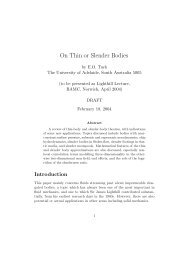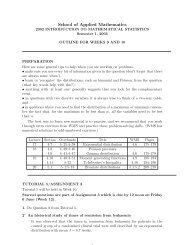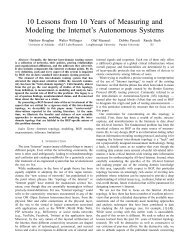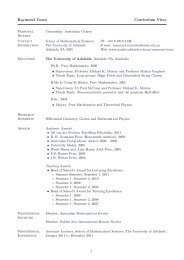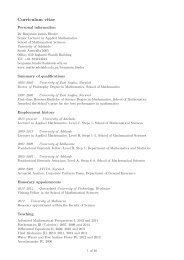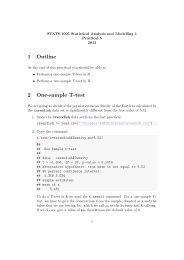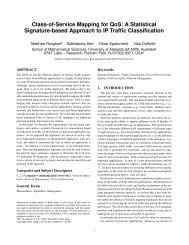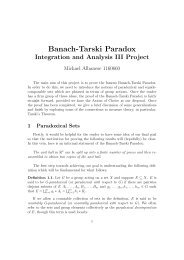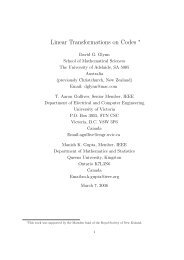Courses available in 2012 - School of Mathematical Sciences - The ...
Courses available in 2012 - School of Mathematical Sciences - The ...
Courses available in 2012 - School of Mathematical Sciences - The ...
You also want an ePaper? Increase the reach of your titles
YUMPU automatically turns print PDFs into web optimized ePapers that Google loves.
<strong>School</strong> <strong>of</strong> <strong>Mathematical</strong> <strong>Sciences</strong><br />
Level II and III <strong>Courses</strong> <strong>in</strong> <strong>2012</strong><br />
October 2011<br />
This document provides <strong>in</strong>formation about the level II and level III courses <strong>of</strong>fered <strong>in</strong> the <strong>School</strong><br />
<strong>of</strong> <strong>Mathematical</strong> <strong>Sciences</strong> at the University <strong>of</strong> Adelaide dur<strong>in</strong>g <strong>2012</strong>. It is <strong>in</strong>tended to assist students<br />
<strong>in</strong> choos<strong>in</strong>g their subjects by provid<strong>in</strong>g a short, readable description for courses <strong>available</strong><br />
at level II or III <strong>in</strong> either Applied Maths (APP MTH), Pure Mathematics (PURE MTH) or Statistics<br />
(STATS) 1 .<br />
Further details <strong>in</strong>clud<strong>in</strong>g detailed course content and contact hours can be obta<strong>in</strong>ed from the<br />
University <strong>of</strong> Adelaide Calendar and Course Planner.<br />
Please note that you are welcome —<strong>in</strong>deed, very much encouraged— to discuss your subject<br />
choices for next year with any <strong>of</strong> your Mathematics or Statistics lecturers, or with one <strong>of</strong> the<br />
<strong>School</strong>’s Course Advisors.<br />
1 A current version <strong>of</strong> this document <strong>in</strong> PDF format is always <strong>available</strong> from the <strong>School</strong>’s web site:<br />
http://www.maths.adelaide.edu.au/students/undergraduate.html
Summary <strong>of</strong> <strong>Courses</strong><br />
Level II<br />
Course Name Code Semester Units<br />
Algebra PURE MTH 2106 1 3<br />
Differential Equations MATHS 2102 1 3<br />
Multivariable & Complex Calculus MATHS 2101 1 3<br />
Probability & Statistics MATHS 2103 1 3<br />
Numerical Methods MATHS 2104 2 3<br />
Optimisation and Operations Research APP MTH 2105 2 3<br />
Real Analysis MATHS 2100 2 3<br />
Statistical Modell<strong>in</strong>g and Inference STATS 2107 2 3<br />
Level III<br />
Course Name Code Semester Units<br />
Applied Probability III APP MTH 3001 1 3<br />
Complex Analysis III PURE MTH 3019 1 3<br />
Computational Mathematics III APP MTH 3000 1 3<br />
Differential Equations III APP MTH 3013 1 3<br />
Groups & R<strong>in</strong>gs III PURE MTH 3007 1 3<br />
<strong>Mathematical</strong> Statistics III STATS 3006 1 3<br />
Number <strong>The</strong>ory III PURE MTH 3003 1 3<br />
Optimisation III APP MTH 3014 1 3<br />
Statistical Modell<strong>in</strong>g III STATS 3001 1 3<br />
Topology & Analysis III PURE MTH 3002 1 3<br />
Waves III APP MTH 3017 1 3<br />
Biostatistics III STATS 3008 2 3<br />
Cod<strong>in</strong>g & Cryptology III PURE MTH 3018 2 3<br />
Communication Skills III MATHS 3015 2 3<br />
Fields & Modules III PURE MTH 3023 2 3<br />
F<strong>in</strong>ite Geometry III PURE MTH 3024 2 3<br />
F<strong>in</strong>ancial Modell<strong>in</strong>g: Tools and Techniques APP MTH 3012 2 3<br />
Fluid Mechanics III APP MTH 3002 2 3<br />
Integration & Analysis III PURE MTH 3009 2 3<br />
<strong>Mathematical</strong> Biology III APP MTH 3004 2 3<br />
Random Processes III APP MTH 3016 2 3<br />
Sampl<strong>in</strong>g <strong>The</strong>ory and Practice III STATS 3003 2 3<br />
Time Series III STATS 3005 2 3<br />
Variational Methods and Optimal Control III APP MTH 3010 2 3
Course Descriptions<br />
Algebra<br />
Back to Summary<br />
Knowledge <strong>of</strong> group theory and <strong>of</strong> l<strong>in</strong>ear algebra is important for an understand<strong>in</strong>g <strong>of</strong> many areas<br />
<strong>of</strong> pure and applied mathematics, <strong>in</strong>clud<strong>in</strong>g advanced algebra and analysis, number theory,<br />
cod<strong>in</strong>g theory, cryptography and differential equations. <strong>The</strong>re are also important applications<br />
<strong>in</strong> the physical sciences.<br />
Applied Probability III<br />
Back to Summary<br />
Many processes <strong>in</strong> the real world <strong>in</strong>volve some random variation superimposed on a determ<strong>in</strong>istic<br />
structure. Often – as <strong>in</strong> games – the random component is the dom<strong>in</strong>ant part. This course<br />
aims to provide a basic toolkit for modell<strong>in</strong>g and analyz<strong>in</strong>g discrete—time problems <strong>in</strong> which<br />
there is a significant probabilistic component. Markov cha<strong>in</strong> examples <strong>in</strong> the course <strong>in</strong>clude<br />
population branch<strong>in</strong>g processes (with application to genetics), random walks (with application<br />
to tennis and other games), and processes with an over–rid<strong>in</strong>g cost structure.<br />
Biostatistics III<br />
Back to Summary<br />
Biostatistics is the branch <strong>of</strong> statistics developed for applications with<strong>in</strong> the biomedical, pharmaceutical<br />
and health sciences. <strong>The</strong>se methods are fundamental to contemporary medical research.<br />
<strong>The</strong>y play a key role <strong>in</strong> evaluat<strong>in</strong>g treatments for diseases such as cancer and heart<br />
disease, <strong>in</strong> predict<strong>in</strong>g the spread and <strong>in</strong>cidence <strong>of</strong> epidemics and <strong>in</strong> evaluat<strong>in</strong>g the risk associated<br />
with factors such as obesity or exposure to electromagnetic radiation. This course provides<br />
an <strong>in</strong>troduction to the design and analysis <strong>of</strong> cl<strong>in</strong>ical trials and epidemiological studies, and<br />
methods for the analysis <strong>of</strong> biostatistical data.<br />
Cod<strong>in</strong>g & Cryptology III<br />
Back to Summary<br />
<strong>The</strong> fundamental objective <strong>of</strong> cryptology is to enable communication over an <strong>in</strong>secure channel<br />
<strong>in</strong> such a way that an eavesdropper cannot understand what is be<strong>in</strong>g said. Classical cryptosystems<br />
required participants to share a common key. <strong>The</strong> new public key systems removed the<br />
need to share a private key. Cod<strong>in</strong>g theory is concerned with f<strong>in</strong>d<strong>in</strong>g efficient schemes by which<br />
digital <strong>in</strong>formation can be coded for reliable transmission through a noisy channel. Error correct<strong>in</strong>g<br />
codes are widely used <strong>in</strong> applications such as transmission <strong>of</strong> pictures from deep space,<br />
storage <strong>of</strong> data on CDs and design <strong>of</strong> identification numbers.<br />
Communication Skills III<br />
Back to Summary<br />
In the modern world, skill at communicat<strong>in</strong>g mathematics is sometimes just as important as<br />
skill at do<strong>in</strong>g mathematics. This course develops students’ skills <strong>in</strong> both the written and verbal<br />
communication <strong>of</strong> mathematics. In addition the general communication skills which are fundamental<br />
to gett<strong>in</strong>g and keep<strong>in</strong>g a job are taught. <strong>The</strong> course encourages student learn<strong>in</strong>g with<br />
a range <strong>of</strong> <strong>in</strong>terest<strong>in</strong>g teach<strong>in</strong>g techniques, <strong>in</strong>clud<strong>in</strong>g guest lecturers and workshops.
Complex Analysis III<br />
Back to Summary<br />
When the real numbers are replaced by the complex numbers <strong>in</strong> the def<strong>in</strong>ition <strong>of</strong> the derivative<br />
<strong>of</strong> a function, the result<strong>in</strong>g (complex-)differentiable functions turn out to have many remarkable<br />
properties not enjoyed by their real analogues. <strong>The</strong>se functions, usually known as<br />
holomorphic functions, have numerous applications <strong>in</strong> areas such as eng<strong>in</strong>eer<strong>in</strong>g, physics, differential<br />
equations and number theory, to name just a few. <strong>The</strong> focus <strong>of</strong> this course is on the<br />
study <strong>of</strong> holomorphic functions and their most important basic properties.<br />
Computational Mathematics III<br />
Back to Summary<br />
In explor<strong>in</strong>g large scale, complex systems, physicists, eng<strong>in</strong>eers, f<strong>in</strong>anciers and mathematicians<br />
<strong>of</strong>ten formulate problems as partial differential equations or many coupled ord<strong>in</strong>ary differential<br />
equations. Only rarely can these mathematical models be solved algebraically. Instead computational<br />
mathematics derives approximate models that form the basis <strong>of</strong> computer predictions.<br />
Such models predict the climate, the weather, option prices, <strong>in</strong>dustrial processes, eng<strong>in</strong>eer<strong>in</strong>g<br />
devices, blood flow, epidemiology and more. This course develops sound stable computational<br />
methods for explor<strong>in</strong>g large-scale systems.<br />
Differential Equations<br />
Back to Summary<br />
Most “real life” systems that are described mathematically, be they physical, f<strong>in</strong>ancial, economic<br />
or some other k<strong>in</strong>d, are described by means <strong>of</strong> differential equations. Our ability to predict the<br />
way <strong>in</strong> which these systems evolve or behave is determ<strong>in</strong>ed by our ability to f<strong>in</strong>d solutions <strong>of</strong><br />
these equations explicitly or to be able to approximate solutions as accurately as we need. Every<br />
differential equation presents its own challenges, but there are various classes <strong>of</strong> differential<br />
equations, and for some <strong>of</strong> these there are established approaches and methods for solv<strong>in</strong>g<br />
them. This course presents some <strong>of</strong> the most important such methods.<br />
Differential Equations III<br />
Back to Summary<br />
Differential equations describe a wide range <strong>of</strong> practical problems <strong>in</strong> areas such as biology, eng<strong>in</strong>eer<strong>in</strong>g,<br />
physical sciences, economics and f<strong>in</strong>ance. This course aims to provide students with<br />
techniques required to solve classes <strong>of</strong> ord<strong>in</strong>ary and partial differential equations that commonly<br />
occur <strong>in</strong> applications.<br />
Fields & Modules III<br />
Back to Summary<br />
This subject presents the foundational material for the last <strong>of</strong> the basic algebraic structures pervad<strong>in</strong>g<br />
contemporary pure mathematics, namely fields and modules. <strong>The</strong> basic def<strong>in</strong>itions and<br />
elementary results are given, followed by two important applications <strong>of</strong> the theory: to the classification<br />
<strong>of</strong> f<strong>in</strong>itely generated abelian groups, and to Jordan canonical form for matrices. <strong>The</strong><br />
subject concludes by return<strong>in</strong>g to fields to present <strong>in</strong>terest<strong>in</strong>g applications <strong>of</strong> the theory.
F<strong>in</strong>ite Geometry III<br />
Back to Summary<br />
Projective geometry is one <strong>of</strong> the important modern geometries <strong>in</strong>troduced <strong>in</strong> the 19th century.<br />
Projective geometry is more general than our usual Euclidean geometry, and it has useful<br />
applications <strong>in</strong> Information Security, Statistics, Computer Graphics and Computer Vision. <strong>The</strong><br />
majority <strong>of</strong> this course will be on projective planes.<br />
F<strong>in</strong>ancial Modell<strong>in</strong>g: Tools and Techniques<br />
Back to Summary<br />
<strong>The</strong> growth <strong>of</strong> the range <strong>of</strong> f<strong>in</strong>ancial products that are traded on f<strong>in</strong>ancial markets or are <strong>available</strong><br />
at other f<strong>in</strong>ancial <strong>in</strong>stitutions, is a notable feature <strong>of</strong> the f<strong>in</strong>ance <strong>in</strong>dustry. A major factor<br />
contribut<strong>in</strong>g to this growth has been the development <strong>of</strong> sophisticated methods to price these<br />
products. <strong>The</strong> significance to the f<strong>in</strong>ance <strong>in</strong>dustry <strong>of</strong> develop<strong>in</strong>g a method for pric<strong>in</strong>g options<br />
(f<strong>in</strong>ancial derivatives) was recognized by the award<strong>in</strong>g <strong>of</strong> the Nobel Prize <strong>in</strong> Economics to Myron<br />
Scholes and Robert Merton <strong>in</strong> 1997. <strong>The</strong> mathematics upon which their method is built is<br />
stochastic calculus <strong>in</strong> cont<strong>in</strong>uous time. B<strong>in</strong>omial lattice type models provide another approach<br />
for pric<strong>in</strong>g options. <strong>The</strong>se models are formulated <strong>in</strong> discrete time and the exam<strong>in</strong>ation <strong>of</strong> their<br />
structure and application <strong>in</strong> various f<strong>in</strong>ancial sett<strong>in</strong>gs takes place <strong>in</strong> a mathematical context<br />
that is less technically demand<strong>in</strong>g than when time is cont<strong>in</strong>uous. This course discusses the b<strong>in</strong>omial<br />
framework, shows how discrete-time models currently used <strong>in</strong> the f<strong>in</strong>ancial <strong>in</strong>dustry are<br />
formulated with<strong>in</strong> this framework and uses the models to compute prices and construct hedges<br />
to manage f<strong>in</strong>ancial risk. Spreadsheets are used to facilitate computations where appropriate.<br />
Fluid Mechanics III<br />
Back to Summary<br />
Fluid flows are important <strong>in</strong> many scientific and technological problems <strong>in</strong>clud<strong>in</strong>g atmospheric<br />
and oceanic circulation, energy production by chemical or nuclear combustion <strong>in</strong> eng<strong>in</strong>es and<br />
stars, energy utilisation <strong>in</strong> vehicles, build<strong>in</strong>gs and <strong>in</strong>dustrial processes, and biological processes<br />
such as the flow <strong>of</strong> blood. Considerable progress has been made <strong>in</strong> the mathematical modell<strong>in</strong>g<br />
<strong>of</strong> fluid flows and this has greatly improved our understand<strong>in</strong>g <strong>of</strong> these problems, but there is<br />
still much to discover. This course <strong>in</strong>troduces students to the mathematical description <strong>of</strong> fluid<br />
flows and the solution <strong>of</strong> some important flow problems.<br />
Groups & R<strong>in</strong>gs III<br />
Back to Summary<br />
<strong>The</strong> algebraic notions <strong>of</strong> groups and r<strong>in</strong>gs are <strong>of</strong> great <strong>in</strong>terest <strong>in</strong> their own right, but knowledge<br />
and understand<strong>in</strong>g <strong>of</strong> them is <strong>of</strong> benefit well beyond the realms <strong>of</strong> pure algebra. Areas <strong>of</strong> application<br />
<strong>in</strong>clude, for example, advanced number theory; cryptography; cod<strong>in</strong>g theory; differential,<br />
f<strong>in</strong>ite and algebraic geometry; algebraic topology; representation theory and harmonic<br />
analysis <strong>in</strong>clud<strong>in</strong>g Fourier series. <strong>The</strong> theory also has many practical applications <strong>in</strong>clud<strong>in</strong>g, for<br />
example, to the structure <strong>of</strong> molecules, crystallography and elementary particle physics.
Integration & Analysis III<br />
Back to Summary<br />
<strong>The</strong> Riemann <strong>in</strong>tegral works well for cont<strong>in</strong>uous functions on closed bounded <strong>in</strong>tervals, but it<br />
has certa<strong>in</strong> deficiencies that cause problems, for example, <strong>in</strong> Fourier analysis and <strong>in</strong> the theory<br />
<strong>of</strong> differential equations. To overcome such deficiencies, a “new and improved” version <strong>of</strong><br />
the <strong>in</strong>tegral was developed around the beg<strong>in</strong>n<strong>in</strong>g <strong>of</strong> the twentieth century, and it is this theory<br />
with which this course is concerned. <strong>The</strong> underly<strong>in</strong>g basis <strong>of</strong> the theory, measure theory, has<br />
important applications not just <strong>in</strong> analysis but also <strong>in</strong> the modern theory <strong>of</strong> probability.<br />
<strong>Mathematical</strong> Biology III<br />
Back to Summary<br />
<strong>The</strong> application <strong>of</strong> mathematics to problems aris<strong>in</strong>g <strong>in</strong> the life sciences is a rapidly grow<strong>in</strong>g area<br />
yield<strong>in</strong>g quantitative understand<strong>in</strong>g <strong>of</strong> questions about such th<strong>in</strong>gs as the spread <strong>of</strong> <strong>in</strong>fectious<br />
diseases, population growth and <strong>in</strong>teraction, organ (e.g. heart) function, cell signall<strong>in</strong>g, nutrient<br />
supply, and more. This course will <strong>in</strong>troduce students to the fasc<strong>in</strong>at<strong>in</strong>g world <strong>of</strong> modell<strong>in</strong>g<br />
biological systems. A variety <strong>of</strong> biological problems will be considered, <strong>in</strong> the context <strong>of</strong> which<br />
students will be exposed to a variety <strong>of</strong> mathematical techniques. No previous exposure to biology<br />
is necessary.<br />
<strong>Mathematical</strong> Statistics III<br />
Back to Summary<br />
Statistical methods used <strong>in</strong> practice are based on a foundation <strong>of</strong> statistical theory. One branch<br />
<strong>of</strong> this theory uses the tools <strong>of</strong> probability to establish important distributional results that are<br />
used throughout statistics. Another major branch <strong>of</strong> statistical theory is statistical <strong>in</strong>ference. It<br />
deals with issues such as how do we def<strong>in</strong>e a “good” estimator or hypothesis test, how do we<br />
recognise one and how do we construct one This course is concerned with the fundamental<br />
theory <strong>of</strong> random variables and statistical <strong>in</strong>ference.<br />
Multivariable & Complex Calculus<br />
Back to Summary<br />
<strong>The</strong> mathematics required to describe most “real life” systems <strong>in</strong>volves functions <strong>of</strong> more than<br />
one variable, so the differential and <strong>in</strong>tegral calculus developed <strong>in</strong> a first course <strong>in</strong> Calculus<br />
must be extended to functions <strong>of</strong> more variables. In this course, the key results <strong>of</strong> one-variable<br />
calculus are extended to higher dimensions: differentiation, <strong>in</strong>tegration, and the l<strong>in</strong>k between<br />
them provided by the Fundamental <strong>The</strong>orem <strong>of</strong> Calculus are all generalised. <strong>The</strong> mach<strong>in</strong>ery developed<br />
can be applied to another generalisation <strong>of</strong> one-variable Calculus, namely to complex<br />
calculus, and the course also provides an <strong>in</strong>troduction to this subject. <strong>The</strong> material covered <strong>in</strong><br />
this course forms the basis for mathematical analysis and application across an extremely broad<br />
range <strong>of</strong> areas, essential for anyone study<strong>in</strong>g the hard sciences, eng<strong>in</strong>eer<strong>in</strong>g, or mathematical<br />
economics/f<strong>in</strong>ance.<br />
Number <strong>The</strong>ory III<br />
Back to Summary<br />
Number theory is one <strong>of</strong> the oldest branches <strong>of</strong> mathematics. It is concerned with the properties<br />
<strong>of</strong> numbers, especially the properties <strong>of</strong> the <strong>in</strong>tegers. Historically, it was valued as the purest
form <strong>of</strong> mathematics, but <strong>in</strong> fact there are many modern applications to <strong>in</strong>formation technology<br />
and cryptography. Number theory is a fundamentally useful course for any mathematician, but<br />
it also attracts a general audience because <strong>of</strong> its <strong>in</strong>tr<strong>in</strong>sic beauty and its emphasis on problemsolv<strong>in</strong>g.<br />
Numerical Methods<br />
Back to Summary<br />
To explore complex systems, physicists, eng<strong>in</strong>eers, f<strong>in</strong>anciers and mathematicians require computational<br />
methods s<strong>in</strong>ce mathematical models are only rarely solvable algebraically. Numerical<br />
methods, based upon sound computational mathematics, are the basic algorithms underp<strong>in</strong>n<strong>in</strong>g<br />
computer predictions <strong>in</strong> modern systems science. Such methods <strong>in</strong>clude techniques<br />
for simple optimisation, <strong>in</strong>terpolation from the known to the unknown, l<strong>in</strong>ear algebra underly<strong>in</strong>g<br />
systems <strong>of</strong> equations, ord<strong>in</strong>ary differential equations to simulate systems, and stochastic<br />
simulation under unknown <strong>in</strong>fluences.<br />
Optimisation and Operations Research<br />
Back to Summary<br />
Operations Research (OR) is the application <strong>of</strong> mathematical techniques and analysis to problem<br />
solv<strong>in</strong>g <strong>in</strong> bus<strong>in</strong>ess and <strong>in</strong>dustry, <strong>in</strong> particular to carry<strong>in</strong>g out more efficiently tasks such<br />
as schedul<strong>in</strong>g, or optimis<strong>in</strong>g the provision <strong>of</strong> services. OR is an <strong>in</strong>terdiscipl<strong>in</strong>ary topic draw<strong>in</strong>g<br />
from mathematical modell<strong>in</strong>g, optimisation theory, game theory, decision analysis, statistics,<br />
and simulation to help make decisions <strong>in</strong> complex situations. This first course <strong>in</strong> OR concentrates<br />
on mathematical modell<strong>in</strong>g and optimisation: for example maximis<strong>in</strong>g production capacity,<br />
or m<strong>in</strong>imis<strong>in</strong>g risk. It focuses on l<strong>in</strong>ear optimisation problems <strong>in</strong>volv<strong>in</strong>g both cont<strong>in</strong>uous,<br />
and <strong>in</strong>teger variables. <strong>The</strong> course covers a variety <strong>of</strong> mathematical techniques for l<strong>in</strong>ear<br />
optimisation, and the theory beh<strong>in</strong>d them. It will also explore the role <strong>of</strong> heuristics <strong>in</strong> such problems.<br />
Examples will be presented from important application areas, such as the emergency services,<br />
telecommunications, transportation, and manufactur<strong>in</strong>g. Students will undertake a team<br />
project based on an actual Adelaide problem.<br />
Optimisation III<br />
Back to Summary<br />
Most problems <strong>in</strong> life are optimisation problems: what is the best design for a rac<strong>in</strong>g kayak, how<br />
do you get the best return on your <strong>in</strong>vestments, what is the best use <strong>of</strong> your time <strong>in</strong> swot vac,<br />
what is the shortest route across town for an emergency vehicle, what are the optimal release<br />
rates from a dam for environmental flows <strong>in</strong> a river <strong>Mathematical</strong> formulations <strong>of</strong> such optimisation<br />
problems might conta<strong>in</strong> one or many <strong>in</strong>dependent variables. <strong>The</strong>re may or may not<br />
be constra<strong>in</strong>ts on those variables. <strong>The</strong>re is always, though, an objective: m<strong>in</strong>imise or maximise<br />
some function <strong>of</strong> the variable(s), subject to the constra<strong>in</strong>ts. This course will exam<strong>in</strong>e nonl<strong>in</strong>ear<br />
mathematical formulations, and will concentrate on convex optimisation problems. Many<br />
modern optimisation methods <strong>in</strong> areas such as design <strong>of</strong> communication networks, f<strong>in</strong>ance,<br />
etc, rely on the classical underp<strong>in</strong>n<strong>in</strong>gs covered <strong>in</strong> this course.
Probability & Statistics<br />
Back to Summary<br />
Probability theory is the branch <strong>of</strong> mathematics that deals with modell<strong>in</strong>g uncerta<strong>in</strong>ty. It is<br />
important because <strong>of</strong> its direct application <strong>in</strong> areas such as genetics, f<strong>in</strong>ance and telecommunications.<br />
It also forms the fundamental basis for many other areas <strong>in</strong> the mathematical sciences<br />
<strong>in</strong>clud<strong>in</strong>g statistics, modern optimisation methods and risk modell<strong>in</strong>g. This course provides an<br />
<strong>in</strong>troduction to probability theory, random variables and Markov processes.<br />
Real Analysis<br />
Back to Summary<br />
<strong>The</strong> underly<strong>in</strong>g theme for this course is that <strong>of</strong> convergence. It is very rare to f<strong>in</strong>d a “real–life”<br />
problem that can be solved exactly, and the best we can usually do is to make approximations.<br />
If such approximations can be made arbitrarily well, we are confronted with the issue <strong>of</strong> a sequence<br />
<strong>of</strong> some k<strong>in</strong>d and its convergence. In this regard, Real Analysis provides students with a<br />
deeper understand<strong>in</strong>g <strong>of</strong> the real numbers and cont<strong>in</strong>uous functions <strong>of</strong> a real variable. It forms<br />
the theoretical foundations for much <strong>of</strong> analysis, and has applications <strong>in</strong> parts <strong>of</strong> Applied Mathematics,<br />
Science, Eng<strong>in</strong>eer<strong>in</strong>g and F<strong>in</strong>ance.<br />
Sampl<strong>in</strong>g <strong>The</strong>ory and Practice III<br />
Back to Summary<br />
Sample surveys are an important source <strong>of</strong> statistical data. A great many published statistics on<br />
demographic, economic, political and health related characteristics are based on survey data.<br />
Simple random sampl<strong>in</strong>g is a well known method <strong>of</strong> sampl<strong>in</strong>g but, for reasons <strong>of</strong> efficiency and<br />
practical constra<strong>in</strong>ts, methods such as stratified sampl<strong>in</strong>g and cluster sampl<strong>in</strong>g are typically<br />
used by statistical authorities such as the Australian Bureau <strong>of</strong> Statistics and by market research<br />
organisations. This course is concerned with the design <strong>of</strong> sample surveys and the statistical<br />
analysis <strong>of</strong> data collected from such surveys.<br />
Statistical Modell<strong>in</strong>g and Inference<br />
Back to Summary<br />
Statistical methods are important to all areas that rely on data <strong>in</strong>clud<strong>in</strong>g science, technology,<br />
government and commerce. To deal with the complex problems that arise <strong>in</strong> practice requires<br />
a sound understand<strong>in</strong>g <strong>of</strong> fundamental statistical pr<strong>in</strong>ciples together with a range <strong>of</strong> suitable<br />
modell<strong>in</strong>g techniques. Comput<strong>in</strong>g us<strong>in</strong>g a high level statistical package is also an essential element<br />
<strong>of</strong> modern statistical practice. This course provides an <strong>in</strong>troduction to the pr<strong>in</strong>ciples <strong>of</strong><br />
statistical <strong>in</strong>ference and the development <strong>of</strong> l<strong>in</strong>ear statistical models with the statistical package<br />
R.<br />
Statistical Modell<strong>in</strong>g III<br />
Back to Summary<br />
One <strong>of</strong> the key requirements <strong>of</strong> an applied statistician is the ability to formulate appropriate<br />
statistical models and then apply them to data <strong>in</strong> order to answer the questions <strong>of</strong> <strong>in</strong>terest.<br />
Most <strong>of</strong>ten, such models can be seen as relat<strong>in</strong>g a response variable to one or more explanatory<br />
variables. For example, <strong>in</strong> a medical experiment we may seek to evaluate a new treatment<br />
by relat<strong>in</strong>g patient outcome to treatment received while allow<strong>in</strong>g for background variables such
as age, sex and disease severity. In this course, a rigorous discussion <strong>of</strong> the l<strong>in</strong>ear model is given<br />
and various extensions are developed. <strong>The</strong>re is a strong practical emphasis and the statistical<br />
package R is used extensively.<br />
Random Processes III<br />
Back to Summary<br />
This course <strong>in</strong>troduces students to the fundamental concepts <strong>of</strong> stochastic modell<strong>in</strong>g with an<br />
emphasis on applications relat<strong>in</strong>g to telecommunication systems. Considerable emphasis is<br />
also placed on the development <strong>of</strong> skills, which are important <strong>in</strong> the workplace. Amongst these<br />
are presentation and communication skills, ability to present a solution <strong>in</strong> terms that the “owner<br />
<strong>of</strong> a problem” can understand, and ability to make decisions about which techniques might be<br />
useful to solve a problem. Application <strong>of</strong> the above skills to sophisticated models <strong>of</strong> telecommunications<br />
systems are developed by students through complet<strong>in</strong>g a series <strong>of</strong> m<strong>in</strong>i-projects.<br />
Time Series III<br />
Back to Summary<br />
Time series consist <strong>of</strong> values <strong>of</strong> a variable recorded over a long period <strong>of</strong> time. Such data arise<br />
<strong>in</strong> just about every area <strong>of</strong> science and the humanities, <strong>in</strong>clud<strong>in</strong>g econometrics and f<strong>in</strong>ance, eng<strong>in</strong>eer<strong>in</strong>g,<br />
medic<strong>in</strong>e, genetics, sociology, environmental science. What makes time series data<br />
special is the presence <strong>of</strong> dependence between observations <strong>in</strong> a series, and the fact that usually<br />
only one observation is made at any given po<strong>in</strong>t <strong>in</strong> time. This means that standard statistical<br />
methods are not appropriate, and special methods for statistical analysis are needed. This<br />
course provides an <strong>in</strong>troduction to time series analysis us<strong>in</strong>g current methodology and s<strong>of</strong>tware.<br />
Topology & Analysis III<br />
Back to Summary<br />
Solv<strong>in</strong>g equations is a crucial aspect <strong>of</strong> work<strong>in</strong>g <strong>in</strong> mathematics, physics, eng<strong>in</strong>eer<strong>in</strong>g, and many<br />
other fields. <strong>The</strong>se equations might be straightforward algebraic statements, or complicated<br />
systems <strong>of</strong> differential equations, but there are some fundamental questions common to all <strong>of</strong><br />
these sett<strong>in</strong>gs: does a solution exist If so, is it unique And if we know <strong>of</strong> the existence <strong>of</strong> some<br />
specific solution, how do we determ<strong>in</strong>e it explicitly or as accurately as possible This course<br />
develops the foundations required to rigorously establish the existence <strong>of</strong> solutions to various<br />
equations, thereby lay<strong>in</strong>g the basis for the study <strong>of</strong> solutions. Through an understand<strong>in</strong>g <strong>of</strong> the<br />
foundations <strong>of</strong> analysis, we obta<strong>in</strong> <strong>in</strong>sight critical <strong>in</strong> numerous areas <strong>of</strong> application, such areas<br />
rang<strong>in</strong>g across physics, eng<strong>in</strong>eer<strong>in</strong>g, economics and f<strong>in</strong>ance.<br />
Variational Methods & Optimal Control III<br />
Back to Summary<br />
Many problems <strong>of</strong> optimisation and control <strong>in</strong> science and eng<strong>in</strong>eer<strong>in</strong>g seek to f<strong>in</strong>d the shape<br />
<strong>of</strong> a curve or surface satisfy<strong>in</strong>g certa<strong>in</strong> conditions so as to maximise or m<strong>in</strong>imise some quantity.<br />
For example, design the shape <strong>of</strong> a yacht hull so as to m<strong>in</strong>imise fluid drag, or control the flight<br />
trajectory <strong>of</strong> a rocket to maximize the height it can atta<strong>in</strong>. Variational methods <strong>in</strong>volve an extension<br />
<strong>of</strong> calculus to handle such problems. This course develops an appropriate methodology,<br />
illustrated by a variety <strong>of</strong> physical and eng<strong>in</strong>eer<strong>in</strong>g problems.
Waves III<br />
Back to Summary<br />
Waves impact on every facet <strong>of</strong> our experience. <strong>The</strong> simple acts <strong>of</strong> see<strong>in</strong>g and hear<strong>in</strong>g rely on<br />
electromagnetic and sound waves. Traffic flows <strong>in</strong> waves. Earthquakes and tsunamis are waves<br />
capable <strong>of</strong> caus<strong>in</strong>g enormous devastation. Waves carry the <strong>in</strong>formation required for our technological<br />
society to function. This course will <strong>in</strong>troduce you to the study <strong>of</strong> waves through a<br />
wide variety <strong>of</strong> examples <strong>of</strong> wave motions.





